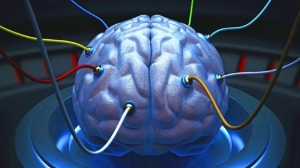In today's era of rapid technological development, Brain-Computer Interface (BCI) is moving from the laboratory to real-world applications at an unprecedented pace. This technology, which can directly enable communication between the brain and external devices, breaks the traditional mode of human-machine interaction by capturing and interpreting brain nerve signals and converting them into instructions recognizable by machines. From helping people with disabilities regain their mobility to revolutionizing the ways of entertainment and education, BCI is reshaping every aspect of human life and becoming one of the most promising development directions in the field of technology.
The Technical Principles and Core Architecture of Brain-Computer Interface
1. Capture and Interpretation of Nerve Signals
The core of BCI lies in the acquisition and analysis of brain nerve signals. The electrical signals generated by brain activities are mainly divided into three types: Electroencephalogram (EEG) signals, Local Field Potential (LFP) signals, and single neuron action potential signals. EEG signals are non-invasively collected through scalp electrodes and can reflect the macroscopic electrical activities of the cerebral cortex. However, their spatial resolution is relatively low, approximately at the centimeter level. LFP signals need to be obtained by implanting invasive electrodes into the superficial layer of the cerebral cortex, and the spatial resolution is improved to the millimeter level, which can more accurately capture the activities of local neuron populations. Single neuron action potential signals are directly recorded by a microelectrode array to record the discharge of a single neuron, with a resolution reaching the micron level, providing the most detailed information on neural activities.
After obtaining the signals, machine learning and signal processing algorithms are needed for interpretation. For example, Convolutional Neural Networks (CNNs) can be used to identify the motor imagery patterns in EEG signals, and Support Vector Machines (SVMs) can effectively classify different neural signal features, thus converting the brain's intentions into executable instructions.
2. Composition of the System Architecture
A typical BCI system consists of a signal acquisition module, a signal processing module, an instruction output module, and a feedback module. The signal acquisition module is responsible for obtaining nerve signals. The signal processing module filters, extracts features, and classifies the original signals. The instruction output module transmits the processed instructions to external devices, such as wheelchairs, prosthetics, or computers. The feedback module then feeds back the execution results of the device to the user in the form of vision, touch, etc., forming a closed-loop control to help the user adjust their brain activities and improve the accuracy of instructions.

Key Advantages of Brain - Computer Interface
Break through Traditional Interaction Limitations
Traditional human - computer interaction relies on physical movements, such as keyboard input and touch - screen operations. However, the brain - computer interface enables "mind control", allowing users to interact with devices solely through brain activities. For patients with physical disabilities caused by diseases or injuries, this provides them with a new way of communication and action, greatly enhancing their self - care ability.
Achieve High - efficiency Information Transmission
In specific tasks, users proficient in using the brain - computer interface can achieve high - efficiency information transmission. For example, in spelling tasks, some brain - computer interface systems can complete input at a speed of 15 - 20 characters per minute. Compared with traditional voice input, it has more advantages in certain scenarios and is not affected by environmental noise.
Explore the Value of Brain Data
The brain - computer interface can collect brain activity data in real - time. These data contain rich information, such as cognitive states and emotional changes. Through the analysis of these data, it can not only help neuroscience research gain a deeper understanding of the working mechanism of the brain, but also provide data support for fields such as mental health monitoring and personalized education.
Exploration of Diverse Application Scenarios
Medical Rehabilitation Field
In the medical field, the brain - computer interface brings hope to patients with nervous system diseases. For patients with amyotrophic lateral sclerosis (ALS), an EEG - based brain - computer interface system can help them control the computer cursor through brain signals, enabling text input and communication. Spinal cord injury patients can use exoskeleton robots controlled by the brain - computer interface to stand up and walk again. Clinical research shows that the degree of nerve function recovery of patients who use brain - computer interface rehabilitation devices for a long time is 30% - 40% higher than that of traditional rehabilitation methods.
Entertainment and Education Fields
In the entertainment industry, the brain - computer interface revolutionizes the gaming experience. Players can control game characters through brain signals, achieving a more immersive gaming experience. For example, in virtual reality games, players can control the movement and actions of characters with their minds without using a gamepad. In the education field, the brain - computer interface can monitor students' learning states and attention levels in real - time. Teachers can adjust teaching strategies accordingly to achieve personalized teaching. At the same time, learning - assisting devices based on the brain - computer interface can help students learn knowledge more efficiently, such as enhancing memory effects by stimulating specific areas of the brain.
Military and Industrial Fields
In the military, the brain - computer interface can be used to quickly transmit combat commands, improving the coordination efficiency between soldiers and equipment. For example, pilots can instantly control the weapon system and flight attitude of fighter jets through the brain - computer interface. In the industrial field, the brain - computer interface can be applied to operations in dangerous environments. Workers can remotely control robots to complete complex tasks through brain signals, avoiding exposing themselves to danger and improving operational safety.
- Prev:None
- Next:Flexible electronic skin
-
Whatsapp
-
Mr. Wu
+86 18620328525 -
Mr. Zhang
+86 15112536677
